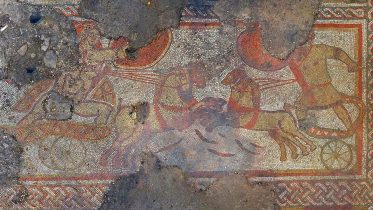
Roman Mosaic
A Roman mosaic is a mosaic made during the Roman period, throughout the Roman Republic and later Empire. Mosaics were used in a variety of private and public buildings, on both floors and walls, though they competed with cheaper frescos for the latter. They were highly influenced by earlier and contemporary Hellenistic Greek mosaics, and often included famous figures from history and mythology, such as Alexander the Great in the Alexander Mosaic. A large proportion of the surviving examples of wall mosaics come from Italian sites such as Pompeii and Herculaneum. Otherwise, floor mosaics are far more likely to have survived, with many coming from the fringes of the Roman Empire. The Bardo National Museum in Tunis has an especially large collection from large villas in modern Tunisia.


